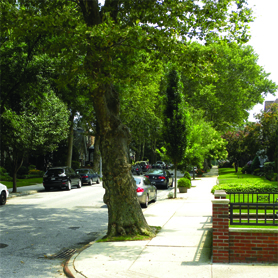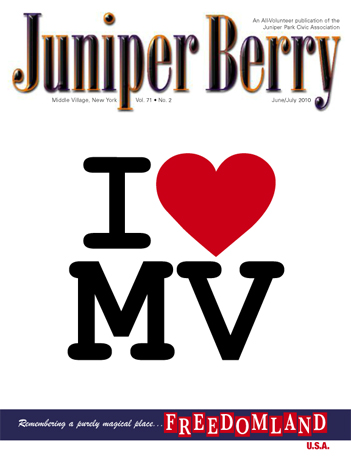An Autonomous Small Town Surviving in a Big City
On October 3, 2008, the New York Times published a profile of Middle Village, designating it “a halfway point where people tend to stay.” The article focused on the inherent charm of our beloved neighborhood, paying specific attention to our quiet dog walkers and joggers as well as the very low residential turnover rate. Quite literally, calling Middle Village a “halfway point” functions as a reference to our convenient location precisely between Jamaica, Queens and Williamsburg, Brooklyn, two heavily populated and frequently trafficked New York City locales. I would like to suggest, however, that Middle Village is a “halfway” point in a different, more metaphorical and visceral way – put simply, we live halfway between two worlds, between two cultures, between two periods of time. We live twenty minutes (if you catch the R or M trains at their best) from Manhattan (“the city”) but we simultaneously inhabit a mostly unadulterated “town,” replete with friendly neighborhood characters, good schools, a large park, and an extremely hands-on, active political scene. Growing up, I often found it difficult to fathom exactly why my neighbors were so invested in our community; what is the appeal of this almost strange, highly specific place? Why do people want to stay here? After leaving Middle Village to live in Manhattan for three and a half years while attending college, I think I finally understand. Middle Village is a halfway point, surely, but it is also a domain of possibility, of unlimited growth within only a few square miles.
Who We Are
Queens, practically by definition, is one of the most diverse counties in the United States. There are endless ethnic pockets, which, for someone obsessed with sampling the food of every culture she can imagine, like I am, is a dream come true. So, while Middle Village and many of its surrounding neighborhoods are predominantly white (almost 90%), Christian, and middle class, there is still, somehow, an undeniable and highly visible diversity – we boast a wide mix of Italian, Irish, German, and Polish families, for instance. While the median age of a Middle Village resident is about 43 (and our most well-represented age group is the 45-49 range), 25% of Middle Village households contain children – children who may go on to attend PS/IS 128, PS 49, Our Lady of Hope School, St. Margaret’s, or Christ the King Regional High School, just a few of our local schools.
It is widely understood that families and individuals remain in
Middle Village for generations – the median year that a Middle Village resident moved into her home is 1983, but I know of many families who have resided in Middle Village since the 1940s or earlier. This low residential turnover rate is, of course, one of our distinguishing characteristics as a community, and undoubtedly contributes to the feeling I touched upon earlier, one of being almost out of time, almost in two eras at once. The many intergenerational households, long-held family businesses, and pronounced absence of too many chain stores and restaurants all contribute to this neighborhood aura, as does the fact that over 30% of Middle Village homes were built in 1939 or earlier. In other words, Middle Village not only feels anachronistic, like a layover from another time, it often looks anachronistic, too.
Pride in Community
Of course, Middle Village is not merely a stagnant, old-world relic. Many residents take pride in the fact that, while their homes may have been built in the 1930s or 1940s and inhabited by their parents or grandparents, they are still seeking out ways to continuously improve and beautify their surroundings. Maria Candela, a resident of Middle Village for nearly thirty years, recognizes this trend of beautification – “people keep their properties nice,” she notes, “they build onto them and maintain them.” Juniper Park Civic Association President, Robert Holden, touches on similar themes when recounting his own family’s history in Middle Village: “As a kid growing up in the 1950s and living on 74th Street (near Caldwell Avenue), most of my relatives lived on the block or across the street. They had friends and neighbors who they grew up with dating back to the 1920s so everyone knew one another. There was really a small town feeling back then. My mother was born in the house that my grandfather built in 1923 on the corner of 58th Road and 74th Street. It’s still standing today and looks pretty much like it did back then.” For Holden, family is central to Middle Village life and is clearly manifested and made physical through his own family’s real estate history. The fact that the house his grandfather built is still standing today contributed to Holden’s own decision to remain in the neighborhood, buy a home, and raise his own children here. After Holden married, he “bought a house on Caldwell Avenue around the corner from where I [he] grew up.” “In fact,” he continues, “my wife’s father grew up in the house that once stood next to our house.” It is evident, through Holden’s recollections and Candela’s observations, that, in Middle Village, the past and the present (and the future, as well) interact in very interesting and fruitful ways. There are, perhaps, equal and equally strong pulls toward both preservation and improvement – the maintenance of the past, and of past relationships and associations, and the creation of new, larger means of forging associations and beautifying our surroundings.
This relationship between the past and the present exists and functions parallel to Middle Village’s position as a place both “inside” and “outside” of the boundaries of New York City. Middle Village, in other words, somehow remains both autonomous (self-sufficient, self-interested) and in dialogue with the city at large. There is no place in which this duality is more apparent than Juniper Valley Park. For many residents, Juniper Valley Park defines Middle Village or, at the very least, is a tangible and easily identifiable answer to the question that I originally set out to answer (that is, why do people want to stay here?). Juniper Valley Park spans approximately fifty-five acres and sits atop the Juniper swamp, which was filled in 1915. During the American Revolution, the park was occupied by British soldiers, but I doubt that these are the kinds of facts that most Middle Village residents would trouble themselves with – we care about the tennis courts, basketball courts, numerous fields and playgrounds, and, most importantly, the fact that the park is within walking distance of nearly every Middle Village resident. The park is certainly one of Frank Catapano’s (forty-three year resident of Middle Village) favorite features of Middle Village life. “The park is fantastic,” he notes, “without this park, a lot of people would be unhappy.” He calls the park his “second home,” and cites the handball and bocci courts as particularly significant. Catapano also stresses Holden’s presence as integral to the park’s (and neighborhood at large) success, noting how tight-knit, responsible, and active the members of the Juniper Park Civic Association have always been. Candela, similarly, points out how close and convenient the park is, not to mention, of course, that it is simply “gorgeous.”
Juniper Valley Park
I have always considered Juniper Valley Park an appropriate and interesting metaphor for our community because it is, certainly, beautiful, singular, and maintained and cherished by our very own residents, while it is just as importantly a New York City Park, under the control of the New York City Department of Parks and Recreation (and within walking distance of the M line, which will transport anyone to downtown Manhattan within thirty minutes). It is, to reiterate, both autonomous and contingent on New York City at large – the park has its own quirky history and its own unique visitors, but it also boasts a view of the New York City skyline that reminds all Middle Village residents that we are New Yorkers, in and of the most remarkable city in the world. My favorite site in all of Middle Village is, in fact, the highest point in Juniper Valley Park, near the flagpole, where one gets the best view of the skyline, where one can stare out at the metal metropolis in the distance while treading on the petal and grass-covered ground beneath. Gazing out at the skyline from Juniper Valley Park creates a sensation of almost cognitive dissonance, to be resolved only by the awareness that this dissonance is a gift, a position to be envied by anyone who ever longed for the quiet of a suburban town and the bustle of an exciting metropolis and thought that she could never have both.



